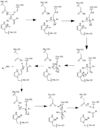User:Luke Edward Severinac/Sandbox 1
From Proteopedia
(Difference between revisions)
| Line 21: | Line 21: | ||
=='''Inhibition'''== | =='''Inhibition'''== | ||
===Zinc Inhibition=== | ===Zinc Inhibition=== | ||
| - | Primary inhibition of Caspase-6 occurs when a zinc ion binds to the exosite containing Lys-36, Glu-244, and His-287 of the active dimer. In addition to these residues, the zinc interacts with one water molecule from the cytoplasm. It has been proposed that helices of the active dimer must rotate or move in some other way to provide these ideal interactions with zinc. This subtle shift is most likely the cause for allosteric inhibition. As the helices move to bind zinc, the amino acids of the active site become misaligned. The altered positions of the amino acids no longer provide ideal interactions for incoming substrates. After zinc binds, no new substrates enter the active site. Thus, Caspase-6 is effectively inhibited. | + | Primary inhibition of Caspase-6 occurs when a zinc ion binds to the exosite containing Lys-36, Glu-244, and His-287 of the active dimer. In addition to these residues, the zinc interacts with one water molecule from the cytoplasm. It has been proposed that helices of the active dimer must rotate or move in some other way to provide these ideal interactions with zinc. This subtle shift is most likely the cause for allosteric inhibition. As the helices move to bind zinc, the amino acids of the active site become misaligned. The altered positions of the amino acids no longer provide ideal interactions for incoming substrates. After zinc binds, no new substrates enter the active site. Thus, Caspase-6 is effectively inhibited<ref name="ZincMediatedCasp6">PMID: 22891250 </ref>. |
===Phosphorylation=== | ===Phosphorylation=== | ||
| Line 29: | Line 29: | ||
=='''Function'''== | =='''Function'''== | ||
===Caspase-6 involvement in Alzheimer's Disease=== | ===Caspase-6 involvement in Alzheimer's Disease=== | ||
| - | Caspase-6 activity is associated with the formation of lesions within the Alzheimer's Disease (AD) and they can become present very early on during the disease's progression. Proapoptotic protein p53 is present at increased levels within AD brains, which seems to directly increase the transcription of Caspase-6. Treatments of Alzheimer's include targeting active Caspase-6 proteins because staining has found active Caspase-6 within the hippocampus and cortex of the Brain within in mild, moderate, and severe cases of AD, which indicates that Caspase-6 plays a predominate role in the pathophysiology of Alzheimer's. There has been research conducted that shows activation of Caspase-6 in AD could cause disruption of the cytoskeleton network of neurons, which then causes handicapped synaptic plasticity. | + | Caspase-6 activity is associated with the formation of lesions within the Alzheimer's Disease (AD) and they can become present very early on during the disease's progression<ref name="ActiveRegofCasp6andNDdisease">PMID: 25340928 </ref. Proapoptotic protein p53 is present at increased levels within AD brains, which seems to directly increase the transcription of Caspase-6. Treatments of Alzheimer's include targeting active Caspase-6 proteins because staining has found active Caspase-6 within the hippocampus and cortex of the Brain within in mild, moderate, and severe cases of AD, which indicates that Caspase-6 plays a predominate role in the pathophysiology of Alzheimer's. There has been research conducted that shows activation of Caspase-6 in AD could cause disruption of the cytoskeleton network of neurons, which then causes handicapped synaptic plasticity. |
Revision as of 03:32, 3 April 2017
Caspase-6 in Homo sapiens
| |||||||||||
References
- ↑ 1.0 1.1 Wang XJ, Cao Q, Zhang Y, Su XD. Activation and regulation of caspase-6 and its role in neurodegenerative diseases. Annu Rev Pharmacol Toxicol. 2015;55:553-72. doi:, 10.1146/annurev-pharmtox-010814-124414. Epub 2014 Oct 17. PMID:25340928 doi:http://dx.doi.org/10.1146/annurev-pharmtox-010814-124414
- ↑ 2.0 2.1 2.2 2.3 Velazquez-Delgado EM, Hardy JA. Zinc-Mediated Allosteric Inhibition of Caspase-6. J Biol Chem. 2012 Aug 13. PMID:22891250 doi:http://dx.doi.org/10.1074/jbc.M112.397752
- ↑ Wang XJ, Cao Q, Liu X, Wang KT, Mi W, Zhang Y, Li LF, Leblanc AC, Su XD. Crystal structures of human caspase 6 reveal a new mechanism for intramolecular cleavage self-activation. EMBO Rep. 2010 Oct 1. PMID:20890311 doi:10.1038/embor.2010.141
- ↑ Velazquez-Delgado EM, Hardy JA. Phosphorylation regulates assembly of the caspase-6 substrate-binding groove. Structure. 2012 Apr 4;20(4):742-51. Epub 2012 Apr 3. PMID:22483120 doi:10.1016/j.str.2012.02.003
Wang, Xiao-Jun, Qin Cao, Yan Zhang, and Xiao-Dong Su. "Activation and Regulation of Caspase-6 and Its Role in Neurodegenerative Diseases." Annual Review of Pharmacology and Toxicology 55.1 (2015): 553-72. Web.
Wang XJ, Cao Q, Liu X, Wang KT, Mi W, et al. 2010. Crystal structures of human caspase 6 reveal a new mechanism for intramolecular cleavage self-activation. EMBO Rep. 11: 841–47
(self cleavage article)
http://www.rcsb.org/pdb/explore/explore.do?structureId=2WDP (this is the non-self cleaved protien)



